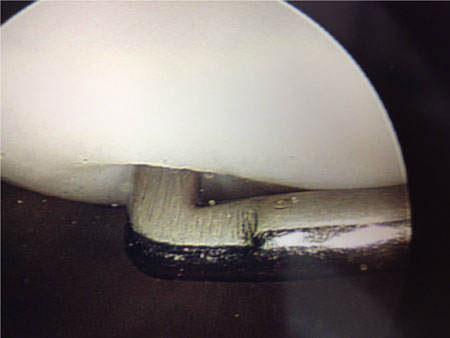Anteromedial tibial tubercle transfer is a powerful procedure to control patellofemoral pain, instability
Anteromedial tibial tubercle transfer, originally described in 1983, effectively moves the patella from tracking laterally and thus unloads the lateral patella while making the patellofemoral joint more congruous and stable. Additionally, because the tibial tubercle is also moved anteriorly, the distal pole of the patella is lifted up thereby unloading distally located patella articular lesions that may be a source of pain. Such lesions are fairly common in association with a lateral tracking, painful patella.
Anteromedial tibial tubercle transfer (AMTTT or AMZ) balances patellofemoral (PF) tracking and unloads distal/lateral patella articular lesions but does not replace medial PF stabilizing procedures for patella instability related to trochlea dysplasia and patella alta or isolated damage to the medial PF retinaculum including the medial PF ligament and medial quadriceps tendon-femoral ligament.

John P. Fulkerson
Distalizing the patella
Recently, attention has focused on relief of patella alta by distalizing the patella to help achieve patella stability related to trochlea dysplasia. The surgeon, however, must be careful not to add load inadvertently to a distal pole articular lesion upon distalizing the patella. In some cases of patella alta associated with lateral patella tracking and a painful distal pole articular lesion (usually indicated by pain upon stepping down with the contralateral leg), distalization of the patella at the time of anteromedial tibial tubercle transfer is indicated, as recommended by Tjoumakaris and colleagues.

Figure 1. Some patients with chronic patellofemoral pain have a soft, painful distal pole articular lesion associated with subtle or overt lateral tracking that causes prolonged and excessive loading of the distal pole with resulting cartilage failure on the distal and lateral aspects of the patella.
Source: Fulkerson JP
Some patients with chronic PF pain have a soft, painful distal pole articular lesion associated with subtle or overt lateral tracking that causes prolonged and excessive loading of the distal pole with resulting cartilage failure on the distal and lateral aspects of the patella (Figure 1). Pidoriano showed that such patients will likely experience pain relief after anteromedial tibial tubercle transfer (TTT).
After prolonged patella lateral tracking, the distal and lateral patella articular cartilage may deteriorate and then collapse to bone over time. Anteromedial TTT works well in such patients for relief of pain, as tracking is shifted more proximally and medially on the patella, off of the painful, previously overloaded patella. AMZ is generally preferable to PF arthroplasty in younger patients (less than 50 years) with lateral PF arthrosis, and may also be preferable in some active patients older than age 50 years.
Medialize the tibial tubercle
When the tibial tubercle–trochlear groove (TT-TG) relationship is greater than 15 mm to 20 mm and a decision is made to medialize the tibial tubercle in the surgical management of recurrent patella instability, the surgeon should evaluate the distal patella articular surface thoroughly and consider anteromedial rather than medial TTT if the distal aspect of the patella shows signs of softening and/or breakdown, particularly if the patient has pain upon stepping down. Anteromedial TTT will diminish the likelihood of postoperative PF pain related to persistent loading of softened distal patella cartilage that can no longer protect aggravated underlying subchondral bone.
In addition to the favorable results of Tjoumakaris and colleagues who reported 97% return to sports after AMZ, Shen and colleagues found Kujala scale improvement from 44 preoperatively to 89 postoperatively at 67-month follow-up. Buuck reported prolonged benefit of anteromedial TTT (AMZ) at 4 years to 12 years. Pidoriano showed that results of AMZ are largely related to articular lesion location and effectively offloading painful patella articular lesions.

Figure 2. The graph demonstrates how the distal patella is unloaded after anteromedial tibial tubercle transfer.
Source: Fulkerson JP
Figure 2 demonstrates how the distal patella is unloaded after anteromedial TTT. Farr and colleagues have recently reviewed and updated the technical details of anteromedial TTT.
The keys to success are technical precision (proper indications, flat oblique osteotomy, secure screw fixation, protected weight bearing for 6 weeks, full motion as soon as possible after surgery). Anteromedial TTT, properly done for the right indications, is a powerful procedure to control PF pain and instability in the hands of a skilled PF diagnostician and surgeon.
References:
Buuck D. Anteromedialization of the tibial tubercle: a 4-12 year follow up. Op Tech Sports Med. 2000;8(2):131-137.
Farr J. Distal realignment for PF disease. In: Surgical Techniques of the Shoulder, Elbow and Knee in Sports Medicine; Cole BJ and Sekiya JK (Eds.); Elsevier; 2013.
Fulkerson JP. Anteromedial tibial tubercle transfer without bone graft. Am J Sports Med. 1990;18:490-496.
Fulkerson JP. Anteromedialization of the tibial tuberosity for patellofemoral malalignment. Clin Orthop. 1983;177:176-181.
Pidoriano A. Correlation of patellar articular lesion location with results from anteromedial tibial tubercle transfer. Am J Sports Med. 1997;25:533-537.
Shen HC. Combined proximal and distal (AMZ) to treat habitual dislocation of the patella in adults. Am J Sports Med. 2007;35:2101-2108.
Tjoumakaris FP. Am J Sports. 2010; Am J Sports Med. 2010;doi:10.1177/0363546509357682.
